Posts
-
Let's Read the 4e Monster Manual 2: Myconids
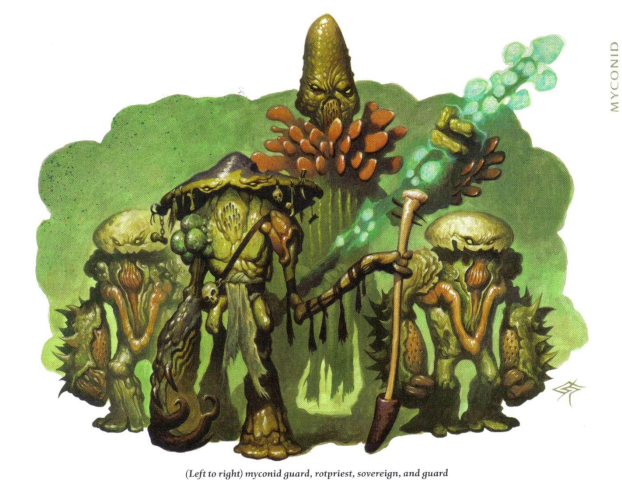
Copyright 2009 Wizards of the Coast Myconids have been in the game since AD&D as one of its most famous “novelty humanoids”. They make their 4e debut here in the MM2.
The Lore
Myconids are sapient fungal humanoids who originated in the Feywild. The fomorians did something to them in the distant past, and they still bear the scars of that corruption. In our narrative present they can be found in deep caves or the Underdark both in the world and in the Feywild. Their preferred environment are underground mushroom forests that provide them with a complete ecosystem to live in, but they also have an instinctive need to multiply and spread and so can be found in less ideal conditions as well.
Myconids communicate by releasing special spores laced with emotions and sensations, which only other myconids can understand. Only one individual in each of their colonies, known as the “Sovereign”, can communicate with outsiders through telepathy.
These mushroom-people aren’t evil, but their expansionist instinct, difficulty with communication, and the fact that they live in the friggin’ Underdark means they tend to engage in conflict with anyone they come across. They often end up enslaved by drow, fomorians, and shadar-kai.
Peaceful interaction with myconids is predictably hard - you have to reach the sovereign, which means infiltrating the heart of their territory or letting yourself be captured and hoping they take you there.
The Numbers
Myconids are Fey Humanoids with the Plant keyword. Sovereigns are Large, everyone else is Medium. They have Tremorsense 10, which allows them to operate well in total darkness. Their signature trait is Roots of the Colony, a free action that triggers when they’re hit by an attack and allows them to split half the damage between themselves and a myconid ally within 5 squares. Given they’re level 3-4, this is likely to be the party’s first encounter with something resistant to focus fire.
Myconid Rotpriest
Myconid culture isn’t well-understood enough for people to know if they worship something, but rotpriests kinda fulfill the “healer” role usually taken up by clerics in other species. They do so in a much more self-sacrificing way, though.
Rotpriests are Level 3 Brutes with the Leader keyword and 48 HP. They have a speed of 5, and Regeneration 5 that can be temporarily disabled by radiant damage. They fight with stipe staffs in melee and can also release decomposing sprays to deal necrotic damage in a Close Burst 3.
They have Roots of the Colony like every other myconid, and when another myconid uses this ability to deal damage to them, rotpriests can use Sacrifice for the Colony to take all of the damage from the trigerring attack instead of just half. The idea is that they then heal this using their regeneration.
When they finally get killed, they release a Life Burst that heals every living creature in a Close Burst 1 for 10 HP. This includes both monsters and PCs!
Myconid Sovereign
Each colony has one of these acting as its leader. As mentioned before, sovereigns are the only myconids with any ability to communicate with outsiders. They’re Level 4 Controllers with the Leader keyword and 58 HP. If forced into a fight they can defend themselves with Slams and with a variety of interesting spore bursts.
The default Spore Burst is a close blast 3 that targets the Will of nonplants and deals poison damage. There’s also Commanding Spores, which allows a plant ally within 5 squares to shift 1 square. Sounds like a waste of a standard action, but it can set up some interesting flanks.
A Sovereign should stay a bit away from the main scrum, spraying it with its spore pesticides and helping keep the PCs surrounded.
Myconid Guard
Though it’s the last monster in the entry, guards are likely to be the most numerous foes the party meets. They’re the rank and file of the colony’s protectors. Guards are Level 4 Soldiers with 56 HP.
They fight with spiny strikes from their fists, and can release pacification spores in a close burst 1 that target enemies’ Wills, do poison damage, and prevent those hit from taking standard actions during their next turns. Fortunately, this is only an encounter power. Roots of the Colony is the last trick on their arsenal.
Front-liners are going to have a bit of a bad time facing down myconid guards, since the guards can stagger their spore releases to keep the PCs from attacking for a while.
Sample Encounters and Final Impressions
Myconids can live in any place that provides good conditions to mundane fungi, such as damp caverns, surface forests, and so on. Encounters with them can involve any wildlife that also lives in these places, either as “third parties” or perhaps as pets if the wildlife is also fungal. They can also be found alongside the several people who enslave their colonies, though in that case you might need to perform some level adjustments.
The sample encounters are an all-myconid party that has just ran into a deathjump spider (level 3); a pair of myconid guards minding an arbalester for their bosses near a patch of green slime (level 4); and a geonid accompanied by a pair of rust monsters and another of rotpriests (level 5).
I like these mushroom people, and I like making then relatively friendly once the PCs manage to breach the communications gap.
-
Let's Read the 4e Monster Manual 2: Marut
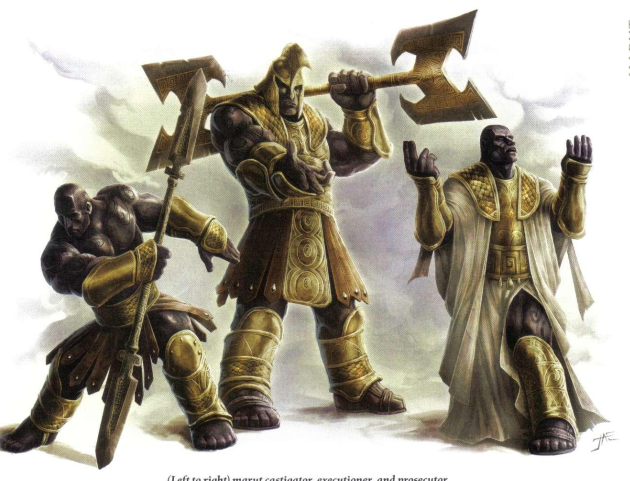
Copyright 2009 Wizards of the Coast Fourth edition Maruts debuted in the first Monster Manual, as enigmatic mercenaries from the Astral Sea that demanded future favors as payment for their services and kept detailed ledgers of these in their astral fortresses. Here we get a bit more lore about them, and three new stat blocks to go with the two from the first MM.
The Lore
The MM2 bits of lore seem to have been written by a different author from the first, and this second author seems to have time-traveled from 3e or 2e. It talks a lot about Maruts being interested in “the upholding of oaths and contracts” in the abstract, which doesn’t really match the first book. Yes, they’re very interested in this stuff, but only when the oaths made by them or to them.
There’s also another bit that says they consider themselves to be “astral spirits of the air”, and despite the convoluted justification accompanying this I don’t think the Astral Sea is a place with strong elemental associations either way.
A more interesting bit is the one that says Maruts aren’t an unified block - they’re divided into groups called “cadres” that hold slighty different philosophies. Each cadre has their own fortress and interacts with other sapients in more or less the same way, but I guess they differ in what they’re stockpiling those favors for.
Some cadres have started calling in a few of their favors and demanding periods of indentured servitude from people. Maruts don’t mistreat their servants, but they’re still demanding and humorless bosses.
The Numbers
The Maruts in this entry are Medium Immortal Humanoids. They have Truesight out to 10 squares, a ground speed of 8, and flight and teleport speeds of 4. They’re immune to sleep and have Resist Thunder 10.
All of the stat blocks in this entry are described as “hunting down those who oppose marut law”, which again doesn’t quite make sense. Pretty much every Marut will hunt and fight someone who backed out of a deal with them, so instead of repeating this I’ll speculate about what someone might hire these new varieties for.
Marut Castigator
Castigators make good bounty hunters, since they’re good at preventing their target from running away. They’re Level 21 Skirmishers with 146 HP and all standard traits. They wield a double sword in combat, and have access to thunder and lightning-themed magic.
Their basic double sword attack can deal physical or lightning damage, at the marut’s discretion. They can also make Double Attacks with it, but not all the time (recharge 4+).
To prevent someone from running, they can use the Punisher’s Lash, a Reach 2 vs. Reflex spell that deals weak lightning damage, slows, and prevents the target from teleporting for a turn. If the target still tries to run, they can give chase with a Thunderbolt Strike, which allows them to teleport 4 squares and make a basic attack with bonus damage afterwards. This recharges when they hit with the two strikes from a double attack.
Marut Prosecutor
Objection! Prosecutors are probably pretty good at that very role during an actual trial, with their epic levels of Insight and Intimidate. They can also use magic to infuse their words with the leaden weight of the law.
Prosecutors are Level 21 Controllers with the Leader keyword and 147 HP. They can punch people with slams that do bonus thunder damage and slow (save ends), but their judicial magic is their greatest asset.
As a minor action they can issue a Dictum (Ranged 10 vs. Fortitude) that does no damage and immobilizes (save ends). They can also use a minor action to mark someone with a Sigil of Indictment (ranged 10 vs. Will), which also does no damage but forces the marked victim to grant combat advantage to the prosecutor and take 5 extra psychic damage from all attacks directed at it. This lasts for a turn and can be sustained, but only one target can bear the Sigil at a time.
Finally, the prosecutor can take a bit more time and spend a standard action to harangue someone with a Biting Testimony (close burst 10, targets one enemy, vs. Will). This deals psychic damage, and inflicts a -2 penalty on all of the target’s attacks, skill checks, and ability checks (save ends).
All of this means prosecutors call the shots during a fight, marking someone with the Sigil and having their allies focus fire on the victim, which they’ll try to immobilize with Dictums. Dictums can also be used to prevent defenders from helping a focused squishy. “Close Burst X; targets one enemy” is just a terse way of saying that power is a ranged attack that doesn’t draw OAs.
Marut Executioner
An executioner is who you call when you need an obstacle removed. When they’re not doing that, they’re out collecting debts owed to their cadre.
Executioners are Level 22 Brutes with 205 HP. They wield Double Axes that does bonus thunder damage, knocks prone on a critical, and can be used in several other maneuvers. Slayer’s Fury (encounter) allows them to attack everyone in a Close Burst 1; Warranted Stroke targets a bloodied enemy, does a ton of damage, always knocks prone, and gives the executioner 1 action point if it drops the target to 0 HP or less.
They can also issue an Execution Call once per encounter, a Close Blast 5 that targets enemies’ Fortitude, does thunder damage, and pulls them adjacent to the executioner. A miss here still does half damage.
Sample Encounters and Final Impressions
I like the mechanics of these new Maruts, but I dislike the throwback to 3e lore here. Law is not a universal cosmic principle in 4e!
The sample encounters have marut mercenary squads accompanying a djinn (level 21) or a trio of rakshasa knights (level 23).
-
Let's Read the 4e Monster Manual 2: Mammoth
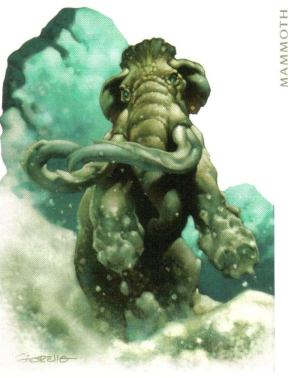
Copyright 2009 Wizards of the Coast Cribbing from paleonthology is one of the classic ways to add interesting monsters to your D&D world. Dinosaurs are the obvious choice, but there’s also a bunch of post-dinosaur megafauna that can be slotted in with no problem at all. Among that set, mammoths are some of the most famous.
Looks like the Monster Manual 2 only had one page to dedicate to them, though, so it decided to skip mundane mammoths altogether and give us a fantastical variety.
Nyfellar Mammoth
These creatures are native to Nyfell, the same frozen realm in the Elemental Chaos from which frost giants originally came. They’re partially made of ice, and subsist on a combination of organic food and ice, so they thrive in the most inhospitable frozen hells.
Frost giants have long ago tamed Nyfellar mammoths for use as mounts, and were responsible for bringing them to the world, where they can still be seen filling that role. I imagine it’s also possible to find wild specimens.
Nyfellar Mammoths are Huge Elemental Beasts with the Mount keyword, and Level 17 Brutes with 202 HP. They have Resist Cold 10 and a respectable ground speed of 8 with Ice Walk, which allows them to ignore “icy” difficult terrain.
They also possess the same Icebound Footing trait that’s common among frost giants, reducing any forced movement inflicted on them by 2 squares, and getting a free save to avoid being knocked prone. They fight with their tusks and big feet in combat.
The tusks are Reach 2 and can either gore as a basic attack or perform a Tusk Toss (recharge 4+) that targets Fortitude, does a little less damage and slides the target 5 squares. At the end of the slide the target falls from a height of 30 feet on the destination square, so it really is a toss. The fall does damage (and can be mitigated) according to the standard rules for falling.
The feet can stamp, a Reach 1 attack that targets fortitude, does about same damage as a gore, and knocks prone. The mammoth can also execute a Blizzard Trample maneuver to move 8 squares, go through enemy spaces, and stamp each of those enemies. This recharges when the mammoth is bloodied, or when it takes cold damage.
If used as a mount, the mammoth can employ a Bitterwind Charge, which allows it to use a Tusk Toss or a Blizzard Trample when charging. Yeah, it moves 8 squares then tramples for another 8 in a single standard action. After this special attack concludes, the rider gets to make a free melee basic attack.
Sample Encounters and Final Impressions
The sample encounter is a level 17 frost giant patrol, with 2 giants riding nyfellar mammoths and accompanied by a rimefire griffon acting as a spotter. The book notes that giants like to play badminton with PCs by readying actions to attack victims of Tusk Toss as they fly by.
These ice mammoths are pretty cool, and I can see why they preferred to include them over the mundane variety. They have a good synergy with frost giants, which also debut in this book.
You could pretty easily derive a mundane mammoth from the nyfellar stat block, making it level 10-13 and removing some of the more blatant elemental abilities. Maybe they could be used as hill giant or ogre mounts then.
-
Nordlond Bestiary Kickstarter!
Gaming Ballistic is about to launch a campaign for the Nordlond Bestiary, and you can go to this page to click a button and be notified of when that happens. Everyone always says GURPS really needs a good bestiary. Well, here’s one!
Contributing to Kickstarter campaigns is a bit hard for me, as my bank dislikes it and tries to cancel my credit card whenever I do it. But if that’s not a problem for you, by all means click that button. I’ll be here waiting for the book’s final launch to buy myself a copy in the traditional way :).
-
Let's Read the 4e Monster Manual 2: Lycanthrope
The first Monster Manual had a Lycanthrope entry containing wererats and werewolves. Here in the second one we get stats for more types, as well as a bit of additional lore.
The Lore
I’ve covered a lot of the basic lore of lycanthropes in the [original article][2], so please read that. This entry adds a couple of other tidbits. The first one says that a lycanthrope’s natural form is the “beast-person” one. The other says that lycanthropes are Melora’s creations, and that the reason they’re affected by silver and the full moon is because of an ancient feud between Melora and Sehanine.
4e lycanthropes aren’t really forced to change in the full moon, so that’s not a big deal, but silver can shut down their regeneration. Like in the first MM, all the stat blocks we get here have “Evil” in their alignment, though there’s no real lore reason for all of lycanthropes to be evil.
The Numbers
Lycanthropes are natural humanoids, and the two we see here are Large. Obviously, they have the Shapechanger keyword. They have low light vision and a ground speed of 6 in either humanoid form or 8 in animal form. Switching forms is a minor action for them, giving them plenty of flexibility in a fight. They have regeneration, which shuts down for a turn when they’re wounded by silver weapons.
Victims damaged by a lycanthrope’s natural attacks while it’s in animal form are exposed to a disease specified alongside their stat block.
Wereboar
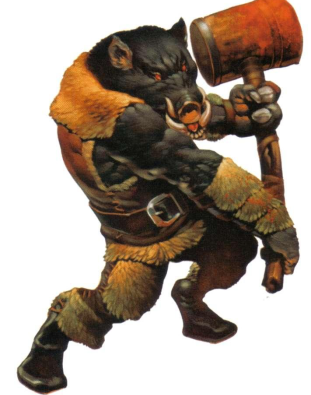
Copyright 2009 Wizards of the Coast Wereboars are described as brutish and easily angered. Some of them like to hang out in places where a fight is likely to break out, such as in rowdy taverns and underground fight clubs. They love to fight in their animal form, and getting wounded only makes them angrier.
The stat block presented here is a Level 6 Brute with 61 HP and all traits listed above. Its regeneration is 5. He fights with a maul in human form and gores with his tusks in boar form. The tusks also inflict ongoing damage and transmit moontusk fever, the wereboar disease.
When bloodied, the wereboar gains a +2 to all defenses and doubles the amount of ongoing damage its tusks deal. And when it hits 0 HP, it can make one last basic attack before dying.
Moontusk fever is a level 6 disease with an “Improve” DC of 17 and a “maintain” DC of 12, and it fucks you up while you’re bloodied. Stage 1 inflicts a -2 penalty so taves while the victim is bloodied. Stage 2 limits them to one save at the end of their turn even if they’re affected by multiple save-ends effects. And the final stage gives you 5e disadvantage on that single save.
The disease isn’t directly lethal, but it’s a major inconvenience given how common saves are in this game. I imagine the actual level of the disease and its DCs should be equal to the level of the wereboar, if you’re changing them.
Weretiger
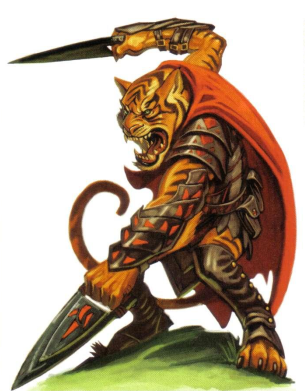
Copyright 2009 Wizards of the Coast Weretigers are a marked contrast to their porcine relatives, being much sneakier and more opportunistic than them in a fight. If they become convinced they need to fight, they’ll stalk their adversary and strike in the most opportune moment. Their fighting style is highly mobile and cautious in any of their forms.
Weretigers are Level 11 Elite Skirmishers with 172 HP and Regeneration 10. They fight with paired katars in humanoid form, and with bites in tiger form. The katars are high-crit weapons and do more damage, but the bite transmits a disease called moon rage.
The weretiger can pounce when it charges, dealing more damage than a basic attack and knocking the target prone on a hit. Feline Fury allows it to make two basic attacks with a shift between them, and Slashing Recoil allows them to make a free basic attack when someone misses them in melee.
While this lycanthrope is stronger in humanoid form, there’s still some incentive to bite the PCs and expose as many of them as possible to moon rage. This is a disease that turns the victim’s hands into tiger paws! At stage 1 the partial change inflicts a -2 penalty on all attacks. At Stage 2 they gain a Strength-based claw attack that deals 1d6+STR bonus damage, but can no longer hold any weapons or implements. And at the final stage their mind is saddled with predatory instincts that prevent them from switching targets in combat until their current target is dead. At level 11, the Improve DC is 21 and the Maintain DC is 16.
Werewolf Lord
This is a bigger, stronger, smarter werewolf, usually found leading a whole clan of lycanthropes. They’re also known as “pack lords”. They’re mostly werewolves with bigger numbers, but they also have some useful leadership powers.
The lord is a Level 13 Elite Brute with 264 HP and Regeneration 10. They project a Blood Moon aura (5) that gives allies inside +2 to attacks and +5 to damage against bloodied targets. They fight with a falchion in humanoid form and with bites in wolf form.
The sword is a High-Crit weapon, and the bite transmits an enhnaced form of moon frenzy. Canine Fury allows them to make 2 basic attacks per action, and Speed of the Wolf allows them to shift 6 squares and bite when in wolf form. Finally, Savage Howl grants 15 temporary HP to every ally within 10 squares and allows them to make free bite attacks if they have any to make.
Greater Moon Frenzy is pretty much werewolf rabies, attacking the nervous system. Stage 1 is a -2 penalty to Will. Stage 2 has the victim make a save at the end of each turn to retain control of their actions. A failure means they must attack a random target within 5 squares or move in a random direction if there are no targets available. Stage 3 removes the save: the victim must attack the closest creature in sight or move in random directions until it finds any. As presented the disease is level 13, with an Improve DC of 23 and a Maintain DC of 18.
Sample Encounters and Final Impressions
I like that the lycanthrope diseases for the wereboar and weretiger are more inconvenient than lethal. A common complaint about 4e diseases is that they’re not very dangerous once the party gets access to the Remove Affliction ritual, which can happen from level 6 onwards. This is true, but curing afflictions can still spend time, money, and healing surges that would be useful elsewhere.
By having somewhat less dangerous diseases, wereboars and tigers paradoxically incentivize players to put up with them for a little longer and try to recover from them using the standard disease rules. So what if your saves suck when you’re bloodied? Just don’t get bloodied until you can return to town and recover!
We get three sample encounters:
-
Level 7: A human hexer, 2 half-orc hunters, and 2 wereboars. It’s either a big brawl in progress, or a group of rowdies looking to start one.
-
Level 12: An eladrin bladesinger, a will-o’-wisp, and 2 weretigers. Fey of a dark disposition who enjoy playing boogeymen and waylaying travelers.
-
Level 13: A werewolf lord, 3 standard werewolves, and 2 worgs. A powered-up version of the typical werewolf-led bandit gang.
-
subscribe via RSS